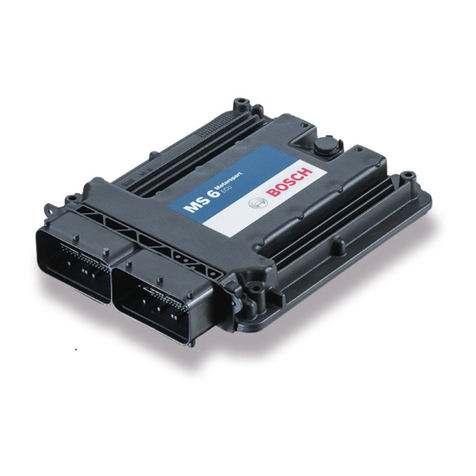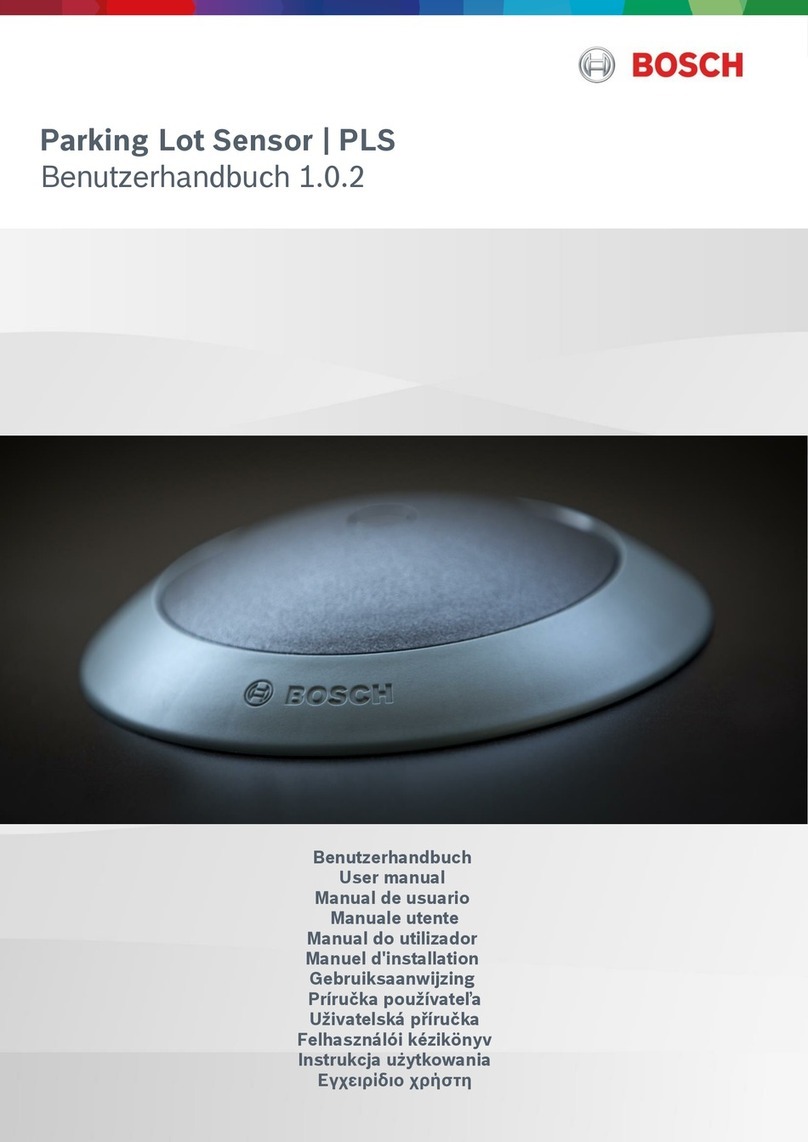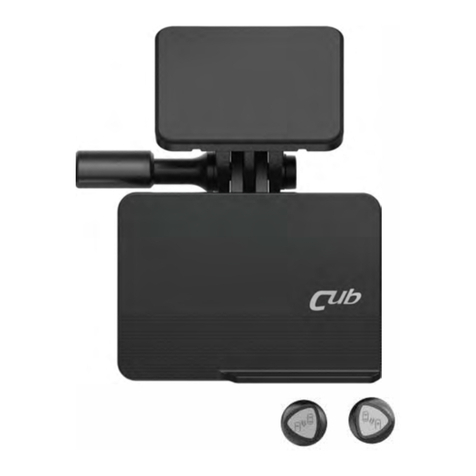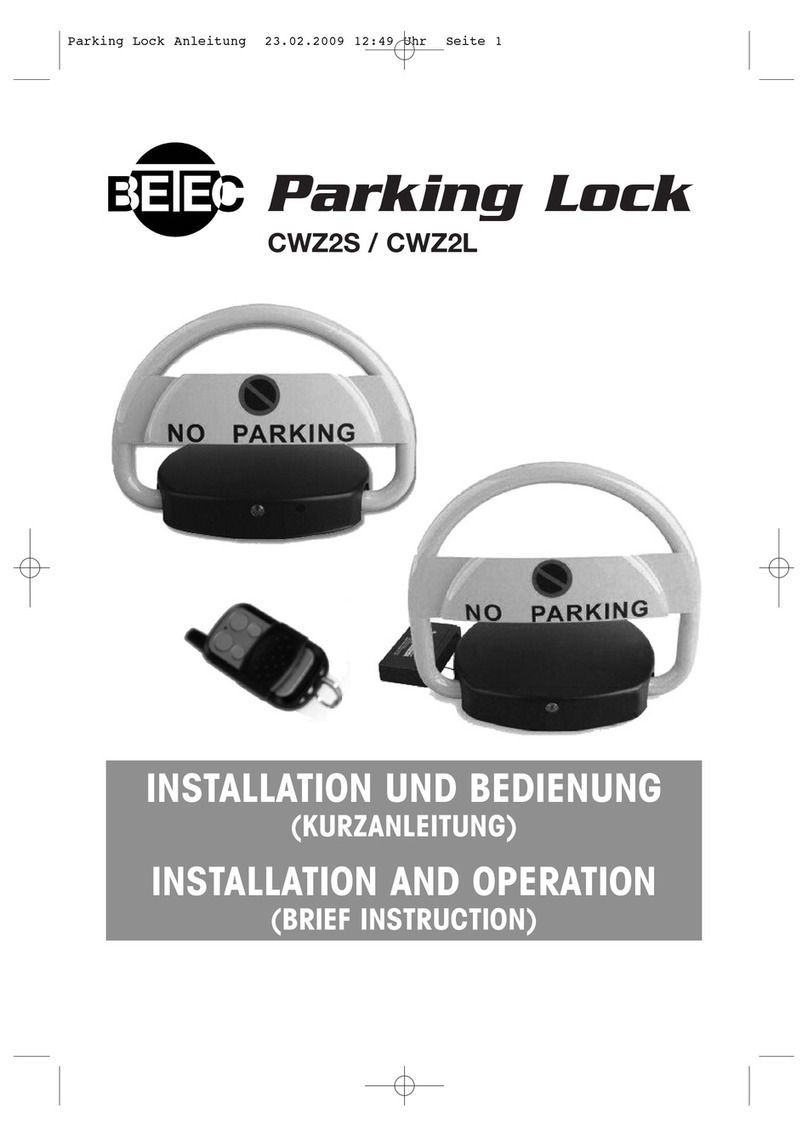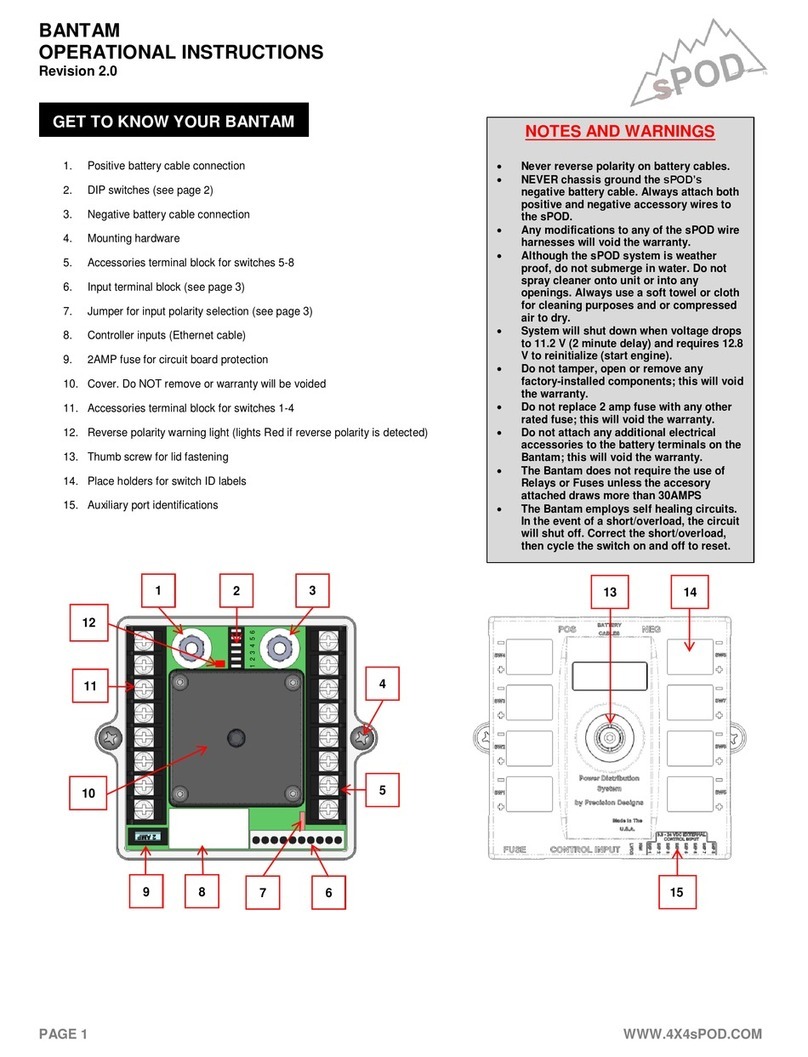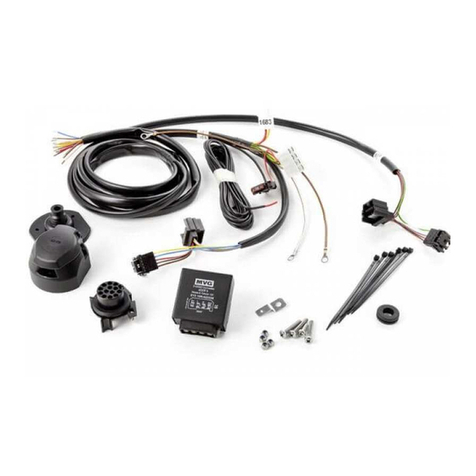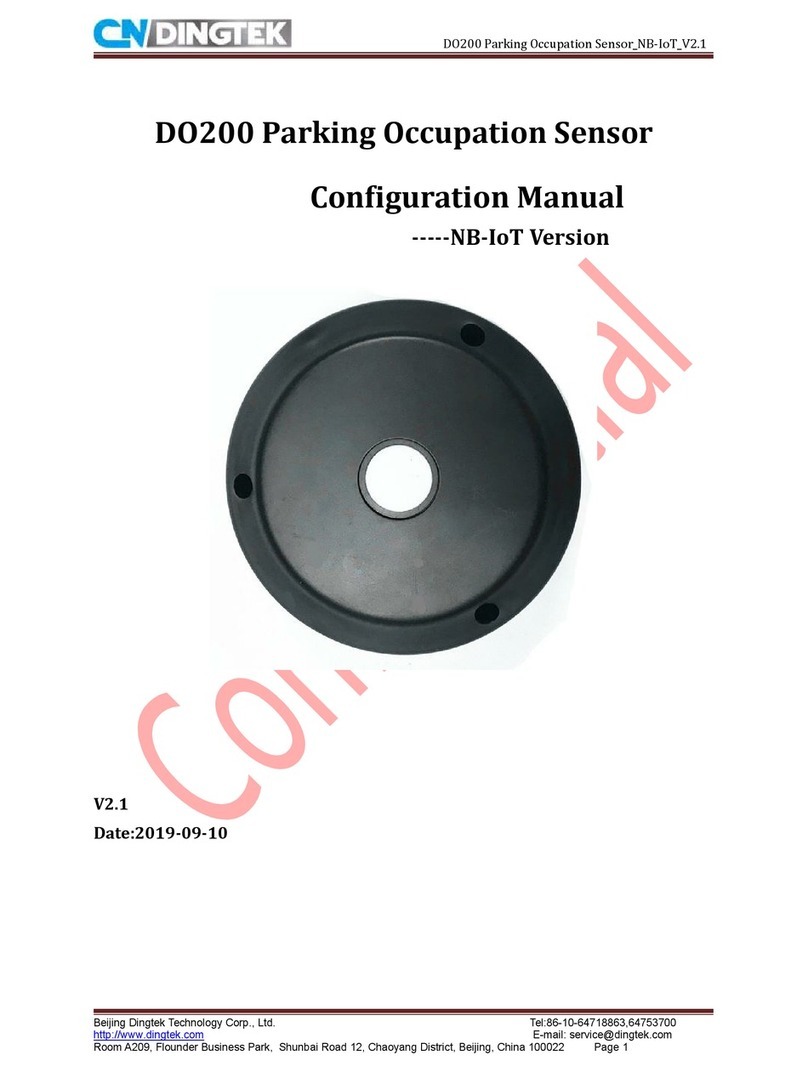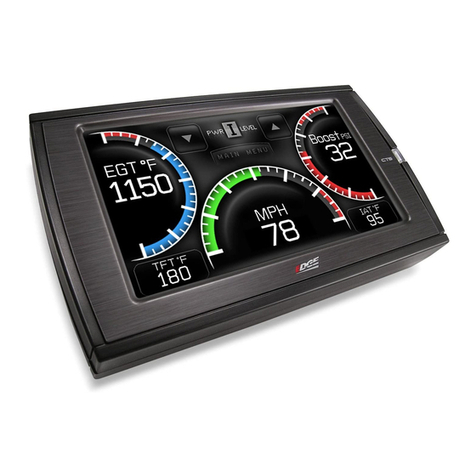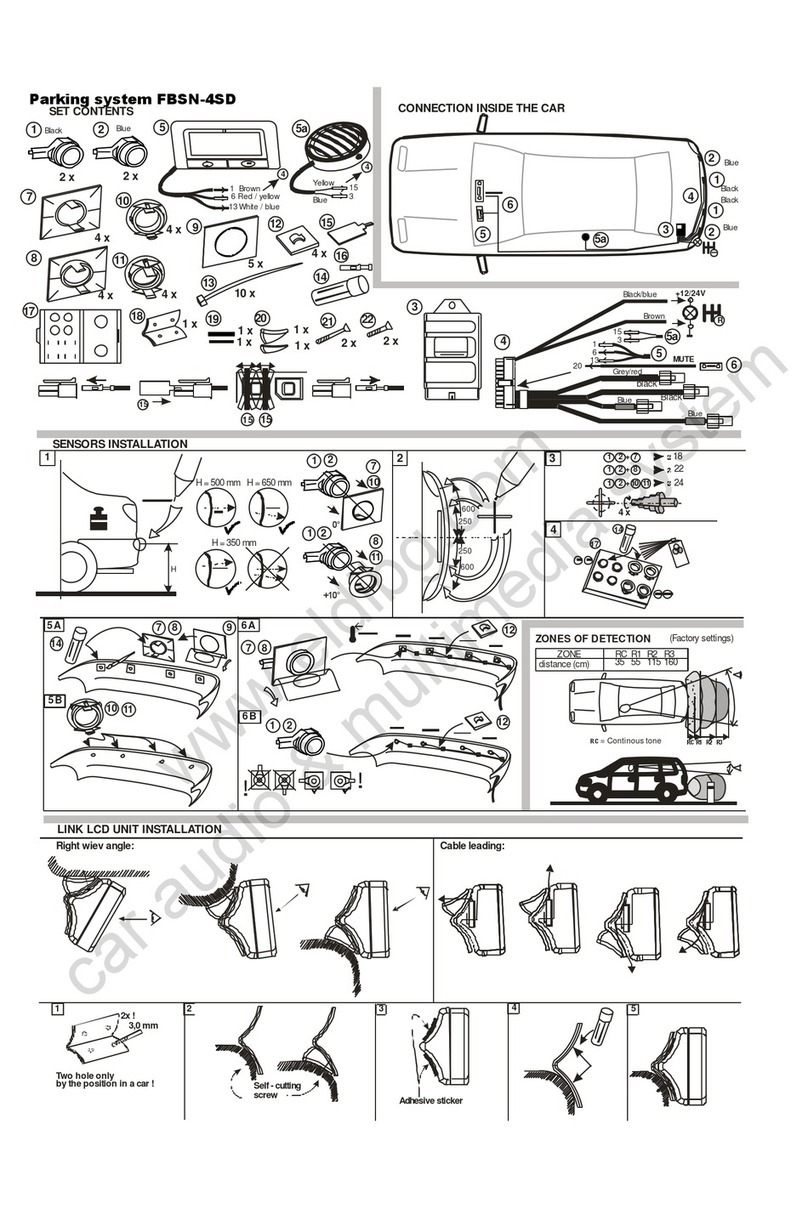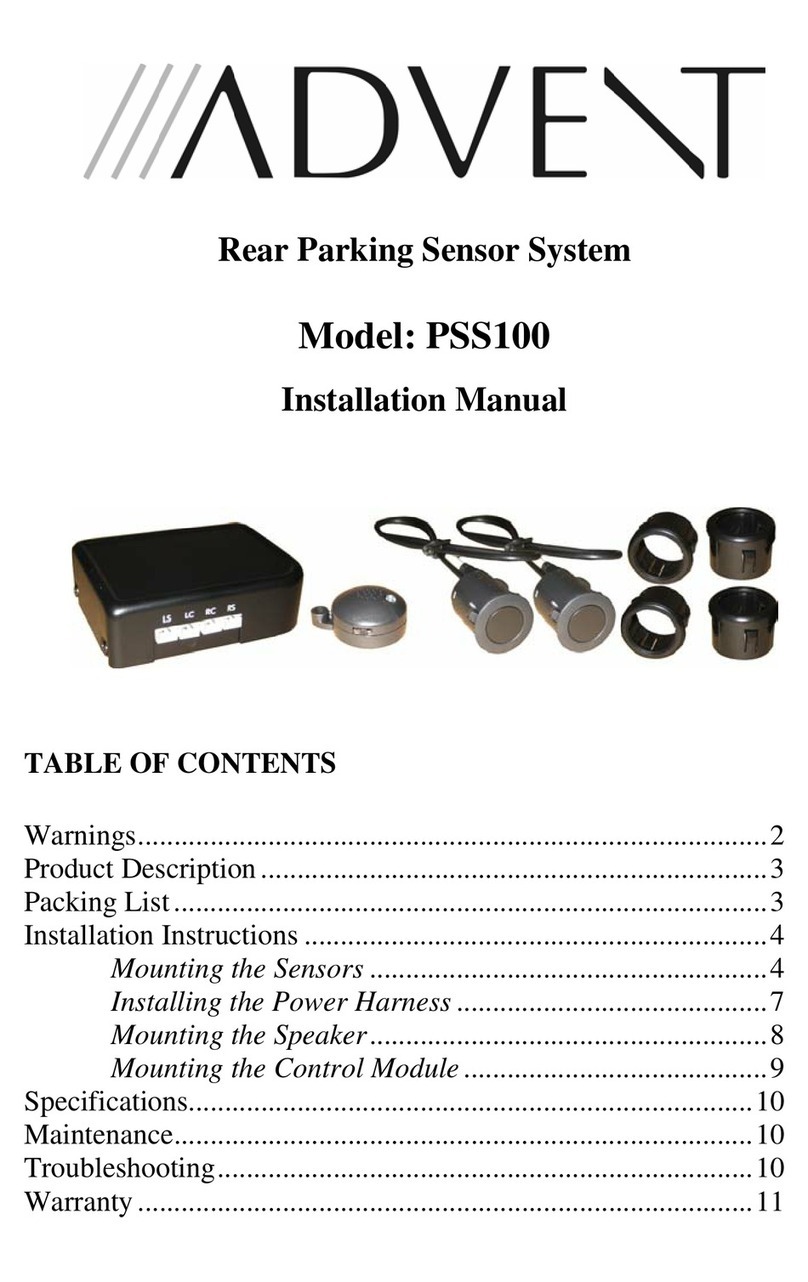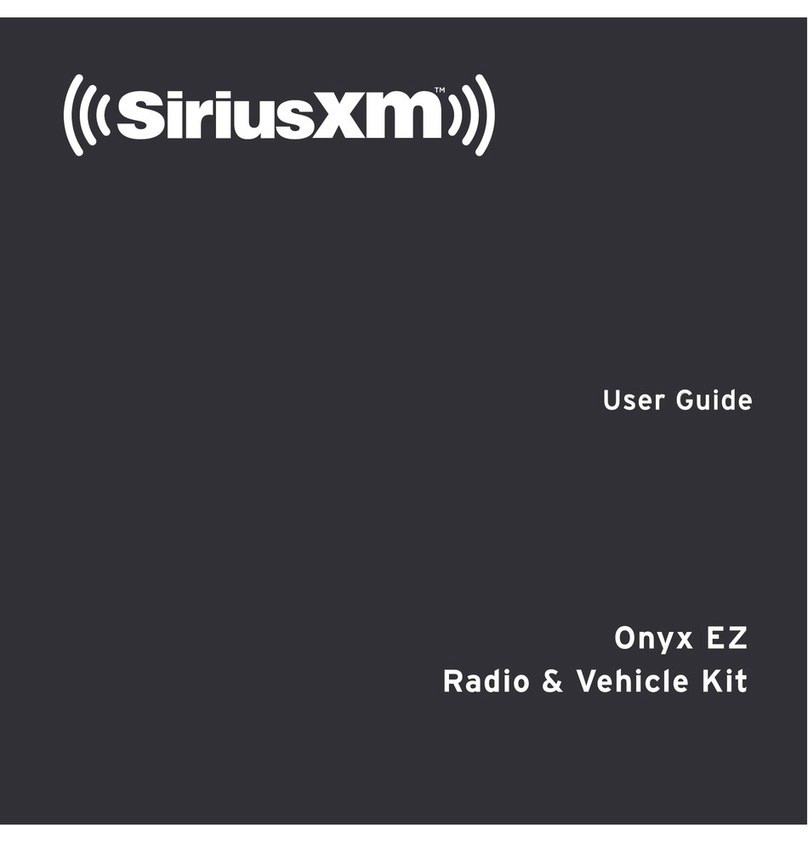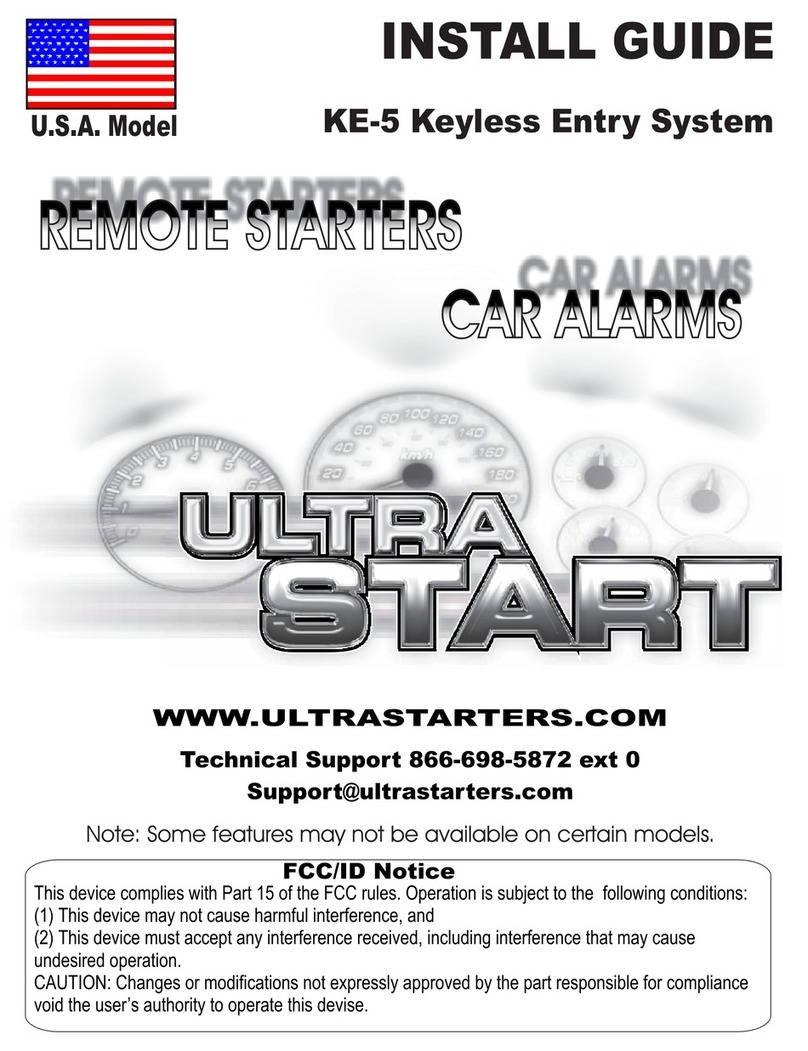Bosch Mastertech Vehicle CommunicationInterface... User manual

Mastertech Vehicle Communication
Interface (VCI) User’s Guide
F00E900173

Robert Bosch LLC VCI User’s Guide | Version 3.1 | April 2012 VCI User’s Guide | Version 3.1 | April 2012 Robert Bosch LLC
The Mastertech Vehicle Communication Interface User’s
Guide provides an overview of the tool.
Everything contained in this manual is based on the
latest product information available at the time of
publication. The right is reserved to make changes at any
time without notice.
No part of this publication may be reproduced, stored
in any retrieval system, or transmitted in any form by
any means, including but not limited to electronic,
mechanical, photocopying, recording, or otherwise,
without the prior written permission of Bosch
Diagnostics. This includes all text, tables, illustrations,
and charts.
Note
If you are reading this guide on your computer,
note that the figures and illustrations are
hyperlinked to the text. To view a figure, simply
click on its reference.
FCC Compliance
This equipment has been tested and found to comply with
the limits for a Class A digital device, pursuant to Part
15 of the FCC rules. These limits are designed to provide
reasonable protection against harmful interference when
the equipment is operated in a commercial environment.
This equipment generates, uses, and can radiate radio
frequency energy. If not installed and used in accordance
with the instruction manual, it may cause harmful
interference to radio communications. Operation of this
equipment in a residential area is likely to cause harmful
interference, in which case the user will be required to
correct the interference at his or her own expense.
VDE and CSA Certification
(Europe and Canada)
This equipment complies with the requirements of VDE
0871/6.78 and CSA Class No. 3631 05,DQD No.548.
Improper use or maintenance neglect may cause
unacceptable radio or TV interference.
Certification Specifications
Pollution Degree: 2
Operational Altitude: 2000 m. (6,500 ft.)
Operational Humidity: 80%
Operational Temperature: 0°C to 50°C
Electrical Input: 7-32 VDC at 750mA max.
Power Supply
The Mastertech VCI base kit includes an external AC to DC
power supply with 100-240 VAC 50/60 Hz input. Output is
12 volts at 1.25 amps.
Caution
These devices are intended for indoor
use only.
Foreword
The Shop Foreman Pro and Mastertech Vehicle
Communication Interface are designed for use by trained
service personnel to diagnose and repair automotive
electronic systems. Every attempt has been made to
provide complete and accurate technical information
based on factory service information available at the time
of publication. However, the right is reserved to make
changes at any time without notice.
To familiarize yourself with the Shop Foreman Pro
applications and its capabilities, and how to use it, please
read through the User’s Guides before putting the VCI
to work.
Shop Foreman Pro provides the following capabilities:
uElectronic Control Unit (ECU) Data Transfer
uShop network communications (LAN and WLAN)
uFuture expandability, including diagnostic applications
Location of Vehicle ECUs and
Test Connectors
For the location of vehicle Electronic Control Units (ECUs)
and Data Link Connectors (DLCs), refer to the Repair
Manual and the electrical wiring diagram for the vehicle
being tested.
Warranty and Repair
Warranty Information
The Mastertech Vehicle Communication Interface is
warranted by Robert Bosch LLC to be free of defects
in material and workmanship for two years. Cables,
adapters, and accessories are warranted for a period of
one year. This warranty period is from the date of sale
to the original consumer. If the product is found to be
defective during this period, the product can be returned
to Robert Bosch repair facility and will be repaired or
replaced free of charge at the sole discretion of Robert
Bosch LLC. This warranty does not cover any part that
has been abused, altered, used for a purpose other
than that of which it was intended, or used in a manner
inconsistent with instructions regarding its use. This
warranty also excludes all incidental or consequential
damages.
Repair Service
If you suspect that you have a problem with this product,
read the operating instructions carefully to ensure that
you are operating the product properly. If it is determined
that a problem exists, please contact the Robert Bosch
Repair Center.
North America: 800-321-4889
Canada: 905-668-2664
Japan: (045) 222-0960
Australia: +61 (2) 98905701
Europe: 49 (0) 607-8428 25
If the product needs to be returned for repair, please
package the product and send it freight prepaid to
the Robert Bosch Repair Center as instructed by the
Technical Service representative (No C.O.D.s please).
Please enclose your telephone number, return address,
and an explanation of the problem. If the product is
determined to be in warranty, it will be repaired or
replaced at no charge and returned freight prepaid. If
determined to be non-warranty, it will be repaired for a
nominal service fee.
Robert Bosch LLC
2030 Alameda Padre Serra, Suite 300
Santa Barbara, CA 93103-9903
Warnings, Cautions, Notes
In the VCI User’s Guide:
uWarnings indicate there is a possibility of injury to you
or other people.
uCautions indicate the possibility of damage to
equipment.
uNotes providing additional information are separated
from the text but do not appear in bold.
Refer to the Repair Manual for the vehicle being tested for
further Warnings, Cautions, and Notes.
Operating Precautions
Warning
When performing any checks with the engine
running in an enclosed space such as a
garage, be sure there is proper ventilation.
Never inhale exhaust gases; they contain
carbon monoxide—a colorless, odorless,
extremely dangerous gas which can cause
unconsciousness or death.
Warning — Set Parking Brake
To help avoid personal injury, always set the
parking brake securely and block the drive
wheels before performing any checks or
repairs on the vehicle.
Caution
Ensure cables and adapters are firmly
connected before starting to use the VCI.
Always read the instructions completely
before attempting a new procedure.

Robert Bosch LLC VCI User’s Guide | Version 3.1 | April 2012 VCI User’s Guide | Version 3.1 | April 2012 Robert Bosch LLC
Contents
i FCC Compliance
i VDE and CSA Certification (Europe and
Canada)
i Using This Manual
i Foreword
i Location of Vehicle ECUs and Test
Connectors
i Warranty and Repair
i Warranty Information
ii Repair Service
ii Warnings, Cautions, Notes
ii Operating Precautions
1 Product Description
1 Mastertech Vehicle Communication Interface Kit
Components
1 VCI Connections
2 Host Computer Interface
2 Universal Serial Bus (USB)
2 Local Area Network (LAN)
3 LAN with Network Router—Straight Ethernet Cable
3 Wireless Local Area Network (WLAN)
4 VCI Manager Application
5 Mastertech Vehicle Communication Interface
Features
5 Data Link Connector And Cable
5 Power Source
5 Battery Operation
5 LEDs
6 Getting Started
6 Using the VCI Manager Application
6 Identifying Your VCI
6 Starting the VCI Manager Application
7 Update VCI Tester Software
8 VCI Network Communications Setup Functions
9 Clear Network Settings
9 Enable Wired Ethernet
14 Setup the VCI for Ad-Hoc Wireless Communication
18 Setup Your PC for Ad-Hoc Communication
19 Recover VCI Tester Software
19 Recovery Procedure
21 Power On Self Test
21 Connecting the VCI to the Vehicle
21 Powering the Mastertech Vehicle Communication
Interface
21 120VAC/12VDC, 1A Power Supply
21 Vehicle Battery
21 Finishing Up
21 Cleaning and Storing Your VCI
22 Battery Replacement
22 Replacing the Batteries
23 Notes
25 Glossary and Abbreviations

Robert Bosch LLC VCI User’s Guide | Version 3.1 | April 2012 VCI User’s Guide | Version 3.1 | April 2012 Robert Bosch LLC
Product Description | Host Computer Interface | 21 | Product Description | Mastertech VCI Kit Components
Product Description
Mastertech Vehicle Communication
Interface Kit Components
The Mastertech Vehicle Communication Interface (VCI)
arrives in a kit which also contains a J1962 16/26 Pin
DLC Cable, 120VAC/12VDC, 1A Power Supply, USB
cable, cable keeper and the media containing diagnostic
application software (figure 1-1). A description of the
VCI hardware and software is included in the following
sections.
Figure 1-1. Mastertech Vehicle Communication Interface Kit
The VCI is used by professional technicians as an aid
in diagnosing and repairing automotive electrical and
electronic systems. The VCI is the connection between
the diagnostic software applications running on the PC
and a vehicle’s electrical and electronic systems.
For details about the diagnostics applications that are
compatible with the VCI, refer to the Bosch diagnostics
website; www.boschdiagnostics.net.
VCI Connections
For the location of the connectors for DC power and
vehicle communication on the VCI, see Figure 1-2.
For the location of the connectors for PC communication
on the VCI, see Figure 1-3.
Figure 1-2. Vehicle Connections to the VCI
Figure 1-3. PC Connections on the VCI
Figure 1-4. PC Standard Indicators (LEDs) and Power Button
For a description and location of the standard indicators
(LEDs) and the power button, see Figure 1-3.
Host Computer Interface
The VCI communicates with a host computer using three
possible interfaces between the VCI and the PC:
uUniversal Serial Bus (USB),
uLocal Area Network (LAN), and
uWireless Local Area Network (WLAN).
Universal Serial Bus (USB)
Note
The USB connection takes priority over
an ethernet or a WLAN connection. All
configuration changes or software updates
are only allowed using the USB connection.
Figure 1-5. USB is the first connection
The VCI has a fixed USB configuration (static IP address)
which cannot be changed. This ensures that the VCI can
always be connected to a PC running diagnostic software
and the VCI Manager application regardless of changes
to LAN or WLAN configurations required by the local
network. Refer to Using the VCI Manager application for
details.
The connectors on the USB cable are slip-in connectors
that do not securely lock in place. In order to keep the
USB cable connected, secure it to the VCI using the
supplied cable keeper. The cable keeper is attached to
the VCI case with a supplied 2.5 mm hex-head screw, the
USB cable is inserted into the slot, and then plugged in as
shown in Figure 1-6.
Figure 1-6. Securing the USB Cable
Local Area Network
(LAN)
A LAN consists of a two or
more computers connected
together using ethernet
cables. The connectors on
both ends of an ethernet
cable are latched. To disconnect them you must press
down on the latch while you pull the connector out.
The VCI’s LAN communication is setup and configured
as required for the user’s local area network using a PC
running the VCI Manager application. The VCI can be
networked using a Direct Connection (crossover ethernet
cable) or a network router (straight ethernet cable). A
brief description of each of these network configurations
follows.
Latch
ESI[tronic] 2.0
Shop Foreman Pro

Robert Bosch LLC VCI User’s Guide | Version 3.1 | April 2012 VCI User’s Guide | Version 3.1 | April 2012 Robert Bosch LLC
Product Description | Host Computer Interface | 43 | Product Description | Host Computer Interface
uDirect Connect—Cross-over Ethernet Cable
uLAN with Network Router—Straight Ethernet Cable
Figure 1-7. Direct Connect—Cross-over
Ethernet able
Figure 1-7, above, shows a computer connected to a VCI
using a cross-over ethernet cable. In this configuration the
computer can communicate directly to the VCI. Most
computers have only a single network interface
connection so in this configuration you will only have
communication to the VCI. Refer to Enable Wired Ethernet
for details on configuring your VCI for communication on a
wired ethernet using a cross-over cable.
Note
A cross-over ethernet cable is required for LAN
Direct Connection. A cross-over cable is not
provided in the Mastertech VCI kit, but can be
purchased at your local computer store.
LAN with Network Router—Straight
Ethernet Cable
Figure 1-8. Connecting to VCIs on the Local Network through a
Network Router
Many offices and shops have computers connected
together using ethernet cables, network routers, and other
items such as printers and modems (internet connection
for email). Figure 1-8, shows one computer connected to
a network router which is then connected to two VCIs. In
an actual network there will typically be several computers
connected into network routers allowing any of the
computers to connect to and control one of the VCIs. Refer
to Enable Wired Ethernet for details on configuring your
VCI for communication on a wired ethernet.
Wireless Local Area Network (WLAN)
The VCI’s 802.11B/G WLAN connection is setup and
configured as required for the user’s local wireless network
using a PC running the VCI Manager application. The VCI
supports both Direct Connect (ad-hoc) and Access Point
wireless configurations. A brief description of each of these
wireless communication configurations follows.
Direct Connect (ad-hoc) Wireless
The ad-hoc wireless option allows you to network your
VCI wirelessly to a computer that has a wireless card and
diagnostic software. This type of connection is also known
as peer-to-peer or Direct Connect, and does not require
a network server or router. An ad-hoc connection may be
ideal for situations where you want to take a notebook
computer into the vehicle as you work with the VCI.
Figure 1-9. VCI Direct Connect Wireless
Note
Although an ad-hoc connection can be done
from the PC’s internal wireless card and the
VCI, Bosch recommends that the ad-hoc
connection between the PC and VCI be done
using a wireless USB adapter connected to
the PC.
The procedure for setting up ad-hoc wireless
communications requires two steps:
1. Use VCI Manager to configure your VCI interface. Refer
to Setup the VCI for Ad-Hoc Wireless Communication
for details.
2. Configure your wireless communications software
on your PC. Refer to Setup Your PC for Ad-Hoc
Communication for details.
Access Point Wireless—Infrastructure Mode
Note
Refer to your access point manual for network
configuration details and suggested operating
distances.
The access point wireless option allows you to connect
your VCI to a WLAN. Depending on the configuration of
your LAN, the communication through an access point can
allow you to access multiple VCIs from multiple PCs. You
must have an 802.11B/G Wireless Access Point connected
to your network within operating range of your work
area. Refer to Setup your VCI for Access Point Wireless
Communication (WLAN) for details.
Note
If you have any set up and connectivity issues
with your access point wireless configuration,
please work with your local IT to get it
resolved.
Figure 1-5. USB is the first connection
VCI Manager Application
The VCI Manager application which is part of the
diagnostics application software is used to configure PC
to VCI interfaces, update VCI software, and test the VCI
interfaces.
To start the VCI Manager application, launch the
appropriate diagnostics software application. This is
either Shop Foreman Pro or ESI[tronic] 2.0.
Note
Clicking the Connect button in VCI Manager
application establishes a connection to the
VCI hardware via USB for configuring network
connectivity (wired/wireless) and for updating
the VCI software. Once VCI Manager is closed,
the connection to the VCI hardware is no longer
enabled. If VCI Manager is reopened, you
must use the Connect button to re-establish
the connection to the VCI hardware for
configuration or software update purposes..
From the M-VCI Selector screen select VCI Manager to
launch the VCI Manager application.
Click VCI Manager
The VCI Manager application provides the following
functions:
Note
If your VCI is connected via USB, the functions
on all tabs are available; if your VCI is not
connected via USB, the functions on the
Network Setup and VCI Update tabs are not
available.
uVCI Explorer - Connect/Disconnect, Interface Details,
Product Help.
uProperties - Interface configuration info.
uVCI Update - Software Updates Availability and
Initialization.

Robert Bosch LLC VCI User’s Guide | Version 3.1 | April 2012 VCI User’s Guide | Version 3.1 | April 2012 Robert Bosch LLC
Getting Started | Using the VCI Manager Application | 65 | Product Description | Mastertech VCI Features
uNetwork Setup - Wired Ethernet, Wireless network
setup.
uHelp - Software Installation Details, Manager Help file,
Print, Shop Foreman Pro software.
The VCI works with the diagnostic application software for
testing specific vehicles and systems. Specific operating
instructions are provided within respective diagnostic
application software.
uThe diagnostic software applications provide the user
interface for communication between the VCI and the
vehicle diagnostic system.
uThe Vehicle System application programs are upgraded
periodically to provide ongoing support for new vehicle
model years, systems, and functions.
uThe Vehicle System application support manuals are
available on the Bosch web site;
www.boschdiagnostics.com.
Mastertech Vehicle Communication
Interface Features
Data Link Connector And Cable
Note
The DLC cable supplied with your VCI is keyed
such that it will only connect to the VCI. It will
not connect to a Mastertech MTS 3100 or Tech
2 and conversely, Mastertech MTS 3100 or Tech
2 cables will not connect to the VCI..
Vehicle diagnostic information is passed between the PC
and the vehicle through the J1962 16/26-pin DLC cable
that is connected to the VCI.
Power Source
The VCI is intended to be powered from the vehicle
battery.
The VCI may also be powered using the 120VAC/12VDC,
1A Power Supply when located near a suitable
wall socket. See Figure 1-11. Typically you use the
120VAC/12VDC, 1A Power Supply during bench
operations when you are configuring the VCI
communications, updating software, and during testing of
the VCI.
Figure 1-11. 120VAC/12VDC, 1 A Power Supply
Battery Operation
Four AAA Batteries are required to power the VCI during
brief power interruption.
The VCI will not operate solely on the batteries, the
VCI must be connected to the vehicle’s 12-volt power
supply during testing or the 120VAC/12VDC, 1A Power
Supply during bench operations such as setting the VCI
configuration options or updating software.
See Chapter 4 for battery replacement instructions.
LEDs
Five Light Emitting Diodes (LEDs), one red and four
green, are located on the front of the VCI as shown in
Figure 1-12. One LED is reserved for future Shop Foreman
Pro software use.
Figure 1-12. LEDs
Future
use LED
Vehicle
Communication
Active
VCI Error
LED
VCI PC
Communication
Active
On/Off
LED
TABLE 1-1. Mastertech VCI Specifications
Item Characteristic
Size 16.7 x 11.4 x 3.8 cm
(6.6 x 4.5 x 1.5 inches)
Weight 0.454 kg (1 lb.)
Power 3.0 Watts @ 12 Vdc
Input Voltage 7 to 32 Vdc
(protected against reverse polarity)
LED Display 5 LEDs — Software controlled on-
board (1 red; 4 green)
Power Sources
12-24 Volt vehicle power
External 120VAC/12VDC,
1A Power Supply
AAA batteries for brief power
interruptions
Operating Temp. 0 °C TO 50 °C (32 °F TO 122 °F)
Storage Temp. -20 °C TO 70 °C (-4 °F TO 158 °F)
Getting Started
Using the VCI Manager Application
Identifying Your VCI
The Mastertech VCI assembly label is located on the
back of the unit. As shown in the illustration at the right,
the assembly identification number has two parts: a
manufacturing code for traceability and a unique serial
number (22000061, in this example). The 8-digit serial
number is used to identify the VCI in the software.
Manufacturing code Serial Number
Starting the VCI Manager Application
Use the following steps to communicate to your VCI with
the VCI Manager application:
1. Apply power to the VCI by connecting the
120VAC/12VDC, 1A Power Supply. You should see the
POST sequence described in Power on Self Test.
2. Connect the USB Cable to the VCI and to your PC. In
order to keep the USB cable connected, you can
secure it to the VCI using the supplied cable keeper.
3. Start ESI[tronic] 2.0 software by double-clicking on
the ESI[tronic] 2.0 software application icon.
4. Select hardware settings... from the main menu.
5. From hardware settings I... screen select VCI Manager
to launch the VCI Manager application.

Robert Bosch LLC VCI User’s Guide | Version 3.1 | April 2012 VCI User’s Guide | Version 3.1 | April 2012 Robert Bosch LLC
Getting Started | VCI Network Communications Setup Functions | 87 | Getting Started | Update VCI Tester Software
Select VCI by
Click to see
6. In the VCI Manager application, VCI Explorer tab,
select the VCI to interface with in the Detected VCIs
window.
Hold your cursor over the VCI icon to see a popup with
the IP address and the configured connections or click
on Show Details to see the detail view of the selected
VCI.
Click on Connect, in either view, to connect to the VCI.
The VCI is displayed with a green check mark on your
display indicating that your VCI Manager application is in
control of that VCI. Once you have connected to a VCI,
another VCI Manager application on another PC will still
detect your VCI but it will be displayed with a red “no”
symbol indicating that it is not available. A VCI can only be
connected to a single PC at a time.
Note
If your VCI is connected via USB, the functions
on all tabs are available; if your VCI is not
connected via USB, the functions on the
Network Setup and VCI Update tabs are not
available.
The VCI Detailed View window shows the PC S/W Version
information for the VCI Manager application and the
VCI S/W Version for the VCI Tester Software as well as
available interfaces and IP addresses, as shown in the
illustration above.
uIf your VCI Manager application is more recent than
the VCI Tester Software, you will need to update your
VCI Tester Software, see Update VCI Tester Software.
uIf your VCI Tester Software is more recent than your
VCI Manager application, you will need to update your
Shop Foreman Pro software. You can download the
latest Shop Foreman Pro software version
from the Bosch Diagnostics website,
www.boschdiagnostics.com.
Update VCI Tester Software
After you install a new Diagnostic application software
version, your VCI Manager application may be more recent
than your VCI Tester Software version. You will need to
connect each VCI that you have via the USB cable to the
PC with the new software and update the VCI Tester
Software.
1. Start the VCI Manager application, refer to Starting the
VCI Manager application.
2. The VCI will appear on the VCI Explorer tab, as shown
below.
B. Click Update VCI
Serial number
A. Click to select
A. Select the VCI.
B. Click the “Update VCI” button.
C. Select software version
D. Click start update
C. Select the latest version of the VCI Tester Software.
D. Click Start Update.
Do not unplug the VCI from the PC or remove
power from the VCI during the update process.
Note
The update process may take up to 30 minutes
to complete per VCI before starting the update
process, make sure you have enough time.
3. When you see the message shown at the right, click
OK.
The VCI Manager application switches automatically to
the VCI Explorer tab and your VCI will appear when it
has finished the restart and Power On Self Test
(POST).
Note
After updating, the VCI restart process will take
a few minutes to complete the boot process as
new files are being written to the SD card.
VCI Network Communications Setup
Functions
The Network Setup tab in the VCI Manager application is
used to change the VCI connection interfaces, wireless
access or security settings, or to clear any previous
network settings.
Note
Do not use a USB hub to connect multiple VCIs
to a PC. The VCI has a static USB address and
address conflicts will occur.

Robert Bosch LLC VCI User’s Guide | Version 3.1 | April 2012 VCI User’s Guide | Version 3.1 | April 2012 Robert Bosch LLC
Getting Started | VCI Network Communications Setup Functions | 109 | Getting Started | VCI Network Communications Setup Functions
Note
You can not change the settings for the USB
interface of the VCI. They are set at the factory
with a static IP address. The PC must also
be set to static IP and have the correct IP
configuration.
You must be connected to the VCI via USB to access
the setting on the Network Setup tab. If you are not
connected via USB you will see the following message and
the entire tab will be grayed out.
Note
After updating, the VCI restart process will take
a few minutes to complete the boot process as
new files are being written to the SD card.
Clear Network Settings
Selecting the Clear Network Settings button will
reconfigure your VCI to the communications settings
it had when it left the factory. Only the USB interface
will be enabled. Any software upgrades that have been
installed to the VCI will still be installed. When the VCI
reset is finished the VCI Manager application will display
the VCI Explorer tab.
Enable Wired Ethernet
The following procedures show some examples of how
to configure your VCI for wired ethernet communication.
Your VCI will need an internet protocol address (IP
Address) which is a unique address assigned to each
computer (or other device) connected within a network.
Things you will need to know:
uIf you are connecting your VCI to a large network with
routers, switches, and other computers, you may have
a dynamic host configuration protocol (DHCP) server
which will automatically assign an IP Address and
Subnet Mask to your VCI each time you connect it to
the network. Refer to Setup your VCI for DHCP LAN
Wired Ethernet Communication—Straight Ethernet
Cable.
uIf you are connecting your VCI to a smaller network
where each computer has a specific IP address, you
will need to assign an unused IP Address and the
Subnet Mask to your VCI. Refer to Setup your VCI for
Static IP Address LAN Wired Ethernet Communication.
uIf you are connecting your VCI to your computer using
a cross-over ethernet cable, you can choose any two
IP addresses which are different only in the last group
of digits. Refer to Setup your VCI for Static IP Address
LAN Wired Ethernet Communication.
Setup your VCI for DHCP LAN Wired Ethernet Communi-
cation—Straight Ethernet Cable
Straight ethernet cable
Network router
1. Start the VCI Manager application. Refer to Starting
the VCI Manager application.
2. Select and Connect to your VCI in the VCI Manager
application, VCI Explorer tab.
3. Select the Network Setup tab.
4. Select the Wired Ethernet tab.
5. Select Enable
Wired Ethernet
Interface
4. Select Wired
Ethernet
7. Click Apply
6. Select Obtain
an IP address
automatically
3. Select
Network Setup
5. Select the Enable Wired Ethernet Interface check box
in the Interface Control box to enable the interface.
Once you enable the interface, the IP Address
Configuration box and the Apply and Cancel buttons
become active. You can start over anytime before you
select Apply by selecting Cancel so that all your stored
changes are discarded.
6. Select Obtain an IP address automatically if your LAN
automatically assigns IP addresses.
7. Click Apply to reconfigure your VCI. You will see the
screen at the right to check your communication
changes.
8. Click Yes to continue, or No to get back to the
Network Setup tab to make any changes.
8. Click Yes
9. Click OK.
If you unplug the VCI from the PC or remove power
from the VCI during the update process, you will have
to recover the VCI. Refer to Recover VCI Tester
Software.
9. Click OK
10.VCI Configuration in Process will flash during the
update process.
Flashing
11.VCI Configuration Complete will be displayed briefly
when the update process is finished.
12.Choose the Properties tab to verify that the VCI is
configured correctly.
12. Select
Properties

Robert Bosch LLC VCI User’s Guide | Version 3.1 | April 2012 VCI User’s Guide | Version 3.1 | April 2012 Robert Bosch LLC
Getting Started | VCI Network Communications Setup Functions | 1211 | Getting Started | VCI Network Communications Setup Functions
13.Record or print your settings as they are displayed on
the Properties tab for future reference. After you have
connected your VCI to the network, the DHCP server
will assign an IP Address and Netmask. Click Refresh
on the Properties tab to see the assigned IP address.
13. Click
Refresh
DCHP assigned
address and
netmask
Setup your VCI for Static IP Address LAN Wired
Ethernet Communication
Note
If you connect your PC and your VCI directly
using a cross-over ethernet cable, you can enter
any static IP address and subnet mask for the
VCI that is identical to your PC’s IP address
except for the final IP address group. For
example: If you PC’s IP address is 10.190.171.4,
the VCI must be set up with an IP address of
10.190.171.“x” where “x” can be any number
except 4. The subnet mask must be the same
on both the PC and the VCI.
1. Start the VCI Manager application. Refer to Starting
the VCI Manager application.
2. Select and Connect to your VCI in the VCI Manager
application, VCI Explorer tab.
3. Select the Network Setup tab.
4. Select the Wired Ethernet tab.
5. Select Enable
Wired Ethernet
Interface
4. Select Wired
Ethernet
7. Click Apply
6. Select Use
the following IP
address
6A. Enter IP
address
6B. Click for
default subnet
mask, change if
required
3. Select
Network Setup
5. Select the Enable Wired Ethernet Interface check box
in the Interface Control box to enable the interface.
Once you enable the interface, the IP Address
Configuration box and the Apply and Cancel buttons
become active. You can start over anytime before you
select Apply by selecting Cancel so that all your stored
changes are discarded.
6. Select Use the following IP address:
A. Enter the IP Address that you have determined will
be unique to your network.
B. The default Subnet mask will usually work. Change
it if required for your network.
7. Click Apply to reconfigure your VCI.
You will see the screen at the right to check your
communication changes.
8. Click Yes to continue, or No to get back to the Network
Setup tab to make any changes.
Click Yes
9. Click OK.
If you unplug the VCI from the PC or remove power
from the VCI during the update process, you will have
to recover the VCI. Refer to Recover VCI Tester
Software.
Click OK
10.VCI Configuration in Process will flash during the
update process.
Flashing
11. VCI Configuration Complete will be displayed briefly
when the update process is finished.
12.Choose the Properties tab to verify that the VCI is
configured correctly.
12. Select
Properties

Robert Bosch LLC VCI User’s Guide | Version 3.1 | April 2012 VCI User’s Guide | Version 3.1 | April 2012 Robert Bosch LLC
Getting Started | Setup the VCI for Ad-Hoc Wireless Communication | 1413 | Getting Started | VCI Network Communications Setup Functions
Setup Your PC for Direct Connection Wired Ethernet
Communication
Note
The following example will configure your
Toughbook PC for a direct connection using
a cross-over ethernet cable. This procedure
is not required if you are connecting your VCI
to a network router that your PC is already
communicating with.
Using the information, shown below, your PC can now be
connected using a cross-over ethernet cable to the VCI to
create a LAN of two devices.
Wired Ethernet State Enabled
Wired Ethernet DHCP/Static Static IP Assignment
Ethernet Hardware Address 00:90:7E:06:04:3F
Wired Ethernet IP Address 10.103.103.123
Wired Ethernet Netmask 255.255.255.0
This process, though essentially the same for any
laptop, will differ somewhat in the details depending
on the specific network interface (NIC) card installed in
your computer. The process described in the following
procedure is specific to the Bosch-recommended
Panasonic ToughBook, however the process should be
similar enough for any notebook PC that has ethernet
capability.
1. Using a cross-over ethernet cable, connect your VCI
and your laptop.
2. Power on both your VCI and your laptop.
After both have booted, the NIC card on the laptop will
see that a network ethernet cable is connected and
start requesting an IP address. (This assumes that the
NIC card is configured for DHCP service from an IP
network.) An icon in the Windows Task Bar will display
two tiny little computers with a message passing from
one to the other. If you place your cursor over this icon
you will see the message “Acquiring network address.”
Eventually, you should see the message “Limited or no
connectivity” as shown below.
3. Double-click
3. From the Windows Task Bar, double-click the Local
Area Connection icon.
Click Properties
4. Click the Properties button
Select Internet
Protocol
Click Properties
5. Select Internet Protocol [TCP/IP].
6. Then, click Properties.
7. Select Use
the following
IP address
8. Enter IP
address
10. Click OK
9. Enter Subnet
mask
7. Select Use the following IP address:
8. Enter the IP address. The IP address on your laptop
must be the same as the IP address on the VCI except
for the last group. In the above example, the VCI uses
123 for the last group while the laptop is using 001.
Note
An important thing to remember when
assigning IP addresses is that they must all be
unique. As long you are networking only your
laptop and your VCI, you can pick any two
numbers as described above. However, if your
laptop has a second ethernet connector or you
plan on connecting to a network using a USB-
to-ethernet adapter, then you must consider
the IP addresses on the entire network to avoid
addressing conflicts.
9. Enter the Subnet mask. The subnet mask on your
laptop must be the same as the subnet mask on the
VCI.
10.Click OK. Then close the remaining connection
windows.
Note
You must have a cross-over ethernet cable in
order for direct connect to work. A straight
through ethernet cable can be used if your PC
supports switching of the Tx and Rx lines.
Setup the VCI for Ad-Hoc Wireless
Communication
Figure 2-6. VCI Ad-Hoc Wireless
The following procedure shows how to configure your
VCI for ad-hoc wireless communication. Using ad-hoc
wireless communication requires that your PC has an
802.11b/g Wireless card or is connected to a wireless N
USB adapter. Before modifying the VCI communications
interface, contact your IT Administrator. If you wish
to setup an access point wireless connection refer to
Setup your VCI for Access Point Wireless Communication
(WLAN).
After you set your VCI ad-hoc wireless configuration, you
will need to setup your PC to communicate to the VCI.
This will be explained for the PC in Setup Your PC for Ad-
Hoc Communication.
1. Start the VCI Manager application, refer to Starting the
VCI Manager application.
2. Select your VCI by comparing the serial number on
the back to the serial number displayed on the screen,
then click Connect. A green check mark appears over
the VCI icon indicating that a connection has been
established.
3. Click the Network Setup tab.

Robert Bosch LLC VCI User’s Guide | Version 3.1 | April 2012 VCI User’s Guide | Version 3.1 | April 2012 Robert Bosch LLC
Getting Started | Setup the VCI for Ad-Hoc Wireless Communication | 1615 | Getting Started | Setup the VCI for Ad-Hoc Wireless Communication
5. Select Enable
Wireless
Interface
4. Click
Wireless
7. Click Apply
6. Click Direct
Connect
3. Click
Network Setup
4. Click the Wireless sub-tab.
5. In the Interface Control section on the right, click the
Enable Wireless Interface check box.
6. Near the bottom of the window, click the Direct
Connect [ad-hoc network] check box.
7. Click the Apply button.
The Apply VCI Network Changes window appears,
displaying your new settings.
8. In the Wireless section, next to Access Point, the New
Settings column should display point-to-point.
8. point-to-point
9. Click Yes
9. Click the Yes button to accept your changes.
10.When the VCI Manager Information dialog appears,
click OK.
The VCI Configuration in Progress message will flash in
the status window. When configuration is complete, VCI
Configuration Complete will be displayed briefly, then
the Connected VCI message displays showing the serial
number of your VCI.
Close the VCI Manager application by clicking the red
“x” in the upper right of the window, but leave the
Mastertech VCI Setup dialog open for now.
You will see that a wireless entry has been created, with
an IP Address still listed as unknown. The VCI is now
configured, though there is still no connection with the
PC. Continue with the procedure, Setup Your PC for Ad-
Hoc Communication.
Setup your VCI for Access Point Wireless Communica-
tion (WLAN)
The following procedure shows how to configure your
VCI for wireless communication through an access point.
You must have an 802.11B/G Wireless Access Point
supporting multicast connected to your network close to
your work area. Before modifying the VCI communications
interface, contact your IT Administrator. If you wish to
setup an ad-hoc wireless connection refer to Setup the
VCI for Ad-Hoc Wireless Communication.
Things you will need to know for Access Point wireless
configuration:
uDoes your LAN automatically assign IP addresses? If
not, you will need an IP Address and Subnet Mask to
assign to your VCI.
uWireless communication access point SSID
(network name)
uRequired network authentication is WPA—Personal,
Open, or Shared
uRequired data encryption is TKIP or WE
(64-bit or 128-bit)
uWireless security password (encryption key)
1. Start the VCI Manager application, refer to Starting the
VCI Manager application.
2. Select and Connect to your VCI in the VCI Manager
application, VCI Explorer tab.
3. Select the Network Setup tab.
4. Select the Wireless tab.
5. Select Enable
Wireless Interface
4. Select Wireless
7. Click Access
Point
6. Select Obtain
an IP address
automatically
3. Select
Network Setup
5. Select the Enable Wireless Interface check box in
the Interface Control box to enable the interface.
Once you enable the interface, you can select Direct
Connect (ad-hoc) or Access Point. If you wish to
setup an ad-hoc connection refer to Setup the VCI for
Ad-Hoc Wireless Communication. If you are setting
up an Access Point connection, continue with this
procedure.
6. Select Obtain an IP address automatically if your LAN
automatically assigns IP addresses. Otherwise enter
the assigned IP Address and Subnet mask.
7. Select Access Point to begin wireless access point
configuration.
8. If you are not within range of the access point you
will use: Select the “Enter Network Name [SSID]:”
radio button and type the network name.
8. Select Enter
Network Name
9. Ensure your PC wireless interface is ON.

Robert Bosch LLC VCI User’s Guide | Version 3.1 | April 2012 VCI User’s Guide | Version 3.1 | April 2012 Robert Bosch LLC
Getting Started | Setup Your PC for Ad-Hoc Communication | 1817 | Getting Started | Setup the VCI for Ad-Hoc Wireless Communication
10.If you are within range of your wireless access point:
Select the “Select from available network list” radio
button.
11.Click Refresh to cause the VCI to search for wireless
network signals. The detected networks are displayed
in the Network Name box.
12.Select a network from the list.
10. Select from
available list
11. Click Refresh
13. Click
Configure
13.Click Configure.
14.Enter the security settings and password that are
required by your network.
15.Click Next>.
15. Click Next14. Enter Security settings
and password
16.Click Yes to reconfigure your VCI, or if you want to
start over select No.
16. Click Yes
17.Click OK. If you unplug the VCI from the PC or remove
power from the VCI during the update process, you
may have to recover the VCI. Refer to Recover VCI
Tester Software.
18.VCI Configuration in Process will flash during the
update process.
Flashing
19.VCI Configuration Complete will be displayed briefly
when the update process is finished.
20.Select the Properties tab to verify that the VCI is
configured correctly.
20. Select
Properties
21.Record or print your settings as they are displayed on
the Properties tab for future reference.
Setup Your PC for Ad-Hoc Communication
Figure 2-7. PC Ad-Hoc Wireless
Now that your VCI is properly configured for ad-hoc
communication, you will need to create a peer-to-peer
network with your computer using the wireless USB
adapter.
1. From the Windows Task Bar, find and double-click the
wireless icon and ensure that Wireless LAN is ON and
enabled.
1. double-click
2. Next, also from the Windows Task Bar, find and
double-click the wireless icon.
2. double-click
3. The wireless dialog will open, displaying a list of all
wireless networks found in your area. These are SSIDs
(Service Set Identifiers) used to identify the different
available networks. Don’t worry about the technical
aspects of this. You just need to find and click the one
for your VCI. To make it easy, the correct SSID is
identified in the dialog box by the serial number of
your VCI.

Robert Bosch LLC VCI User’s Guide | Version 3.1 | April 2012 VCI User’s Guide | Version 3.1 | April 2012 Robert Bosch LLC
Getting Started | Recover VCI Tester Software | 2019 | Getting Started | Recover VCI Tester Software
3. Click to select
4. Click Connect
4. Click the Connect button
5. A message appears at the top of the dialog telling you
that you are now joined to the ad-hoc network you
have created. The yellow network icon on the task bar
should now turn green, further indicating that you
have a live connection.
6. Close wireless dialog by clicking its Close button.
7. If you still have the Mastertech VCI Setup dialog open,
click the Refresh button.
8. The dialog updates to show the wireless IP Address for
your VCI.
Your wireless ad-hoc network is now be ready to use.
Recover VCI Tester Software
As a result of a power failure or a communications error
during a software update, the VCI Tester Software may
become corrupted. You may see several symptoms such
as error messages directing you to go to RECOVERY mode
or an inability to connect to a detected VCI.
The two error messages below would generally occur
during VCI Tester Software download. If you see either of
these messages, perform the Recovery Procedure.
Recovery Procedure
Connect your VCI to the PC using the USB cable.
The following procedure will place the VCI in a RECOVER
state.
1. Remove power from the VCI. This may require
disconnecting the power cord and pressing the Power
button. Ensure that all the LEDs are off. If the VCI
Power button does not shut off the power after the
power cord is removed, remove the batteries. Refer to
Replacing the Batteries.
2. Press and hold the Power button down while you apply
power to the VCI. When you see all the LEDs light as
shown at the right (about 10 seconds), release the
Power button. The VCI will start up in a recovery state
with only the Power On LED lit. Continue with the next
step.
1. Start the VCI Manager application, refer to Starting the
VCI Manager application.
Note
Your VCI must be connected via USB or it will
not be recognized.
2. Select the VCI displaying the serial number matching
your VCI.
3. Click Recover.
The VCI Manager application switches automatically to
the VCI Update tab.
Note
The recovery process could take up to 30
minutes.
2. Click to select
3. Click Recover
Note
The recovery procedure will clear the VCI
network settings.
4. Select the latest version of the VCI Recovery Image.
5. Click Start Update.
Do not unplug the VCI from the PC or remove power
from the VCI during the recovery process.
4. Click to select
3. Click Start
Update
6. When you see the message shown at the right, click
OK.
The VCI Manager application switches automatically
to the VCI Explorer tab and your VCI will appear when
it has finished the restart and Power On Self Test
(POST).
Note
After recovering the software, the VCI takes a
few minutes to reboot the first time.

Robert Bosch LLC VCI User’s Guide | Version 3.1 | April 2012 VCI User’s Guide | Version 3.1 | April 2012 Robert Bosch LLC
Battery Replacement | Replacing the Batteries | 2221 | Getting Started | Power On Self Test
Power On Self Test
Turn on the VCI by connecting to power (A/C 12-V adapter
or vehicle’s DLC port).
When you first apply power to the VCI, the Power On Self
Test (POST) will run. You should observe the following
sequence of lights and hear the “BEEP’ indicating that the
VCI is working properly.
Quick flash
1st stage
2nd stage
3rd stage, then “beep”
Error detected
Connecting the VCI to the Vehicle
The Mastertech Vehicle Communication Interface kit
contains the following cable to connect the VCI to the
vehicle.
J1962 16/26 pin Data Link Connector (DLC) cable
Refer to the Repair Manual or the electrical wiring
diagram for the vehicle you are testing to determine the
location and type of Data Link Connector (DLC) installed
on the vehicle.
1. Connect the 26-pin end of the DLC cable to the bottom
of the VCI, then tighten the screws.
2. Connect the 16-pin end of the DLC cable to the vehicle
DLC connector.
Powering the Mastertech Vehicle
Communication Interface
The VCI can be powered by the vehicle’s 12-volt battery or
by the 120VAC/12VDC, 1A Power Supply. The internal AAA
batteries provide power only for short intermittent power
outages.
120VAC/12VDC, 1A Power Supply
Connect the 120VAC/12VDC, 1A Power Supply to the
bottom of the VCI, then plug the power supply into a
standard wall outlet.
Vehicle Battery
The VCI is powered directly by the DLC cable when the
cable is connected to the vehicle DLC.
Finishing Up
After using the Mastertech Vehicle Communication
Interface (VCI), a few simple steps will help you leave the
vehicle electronic system(s) in the proper state and also
ensure that you get the most use out of your diagnostic
tools:
1. Reconnect all hoses, connectors, spark plug wires,
fuel lines, etc. that were disconnected from the vehicle
during testing.
2. Before turning the VCI off, exit Shop Foreman Pro
software.
3. Turn the VCI off by pressing the on/off button.
The LED turns off.
4. Disconnect the VCI’s J1962 16/26 Pin DLC cable from
the vehicle.
5. Disconnect the USB or ethernet cable from the PC and
the VCI.
6. Inspect the cables and connectors for damage and
corrosion. Replace faulty components immediately.
7. Store the VCI, cables, and other parts in a secure, dry
location.
Cleaning and Storing Your VCI
If the VCI, connectors, or cables become dirty, they
may be cleaned by wiping them with a rag lightly
coated with a mild detergent or non-abrasive hand
soap. Do not immerse the VCI or any of its parts or
accessories in water. Avoid using harsh solvents such
as petroleum based cleaning agents, Acetone, Benzene,
Trichloroethylene, etc. Although the VCI and accessories
are water resistant, they are not waterproof; thoroughly
dry them prior to storage.
Battery Replacement
Note
Know the Law! Dispose of batteries legally!
Batteries are considered hazardous waste
under many local laws or regulations and
may not be discarded in the municipal waste
system. Check with local solid waste officials
in your area for recycling options or proper
disposal methods. Many local government
agencies and businesses run programs
that help businesses properly dispose of
hazardous wastes.
Replacing the Batteries
The VCI contains four AAA batteries. The batteries are
not intended to power the VCI. The batteries only provide
back-up power for momentary power interruptions like
those that can occur during engine cranking.
The batteries will supply power to keep the VCI running
for about 30 seconds before shutting it down.
To replace the batteries:
1. Install new batteries with the positive (+) and negative
(-) terminals oriented as indicated on the inside of the
battery enclosure.
2. Place the cover on the battery case so the tabs at the
top of the cover are aligned with the slots in the case,
and the slots at the bottom of the cover are aligned
with the tabs on the case.
3. Press the arrow on the battery cover while pushing
the cover toward the top of the case. The cover should
snap into place.
Figure 1. Install the Mastertech Vehicle Communication
Interface Batteries
Remove boot
Turn over, slide open,
and remove battery door.
Install four AAA batteries.
The negative (flat) end
of the battery is always
installed to contact the
spring.

Robert Bosch LLC VCI User’s Guide | Version 3.1 | April 2012 VCI User’s Guide | Version 3.1 | April 2012 Robert Bosch LLC
Notes | 2423 | Notes
NotesNotes

Robert Bosch LLC VCI User’s Guide | Version 3.1 | April 2012 VCI User’s Guide | Version 3.1 | April 2012 Robert Bosch LLC
Glossary and Abbreviations | 2625 | Glossary and Abbreviations
Term Definition
802.11 B/G TCP/IP standard for transmitting and receiving wireless communications.
AC Alternating Current
Access point A device that connects wireless communication devices together to create a wireless
network.
Ad-hoc mode A direct connection between the Mastertech VCI and the PC without a network.
BAUD RATE The speed at which data is transferred over a serial data link.
bps Bits per second. Unit used for baud rate.
Cable keeper Rubber grommet used to keep the USB cable connected to the VCI.
Cross-over ethernet cable Twisted pair ethernet cable with wires connected differently at one of its ends.
CURSOR Highlighted text or data on a display screen. Same as Marker.
DC Direct Current
DCE Data Communication Equipment. A term used to describe a device connected to an
RS232 link.
DHCP Dynamic Host Communication Protocol used for assigning IP addresses.
Direct Connect Communication connection directly between a VCI and a PC. The connection can be
either wireless (Ad-Hoc) or wired (cross-over ethernet cable).
DLC Data Link Connector
DTE Data Terminal Equipment. A term used to describe a device connected to an RS232 link.
ECM Engine Control Module
ECU Electronic Control Unit
EEPROM Electronically Erasable PROM
Ethernet Standardized IEEE 802.3 twisted-pair wire for connecting systems to a network is the
most widespread wired LAN technology.
Firewall Software that prevents forbidden communications from entering your network.
Host ID Alphanumeric sequence used to license Shop Foreman Pro software.
Hz Hertz, a unit of measure for frequency.
I/F Interface
I/O Input/Output
I/P Instrumentation Port
IP address Internet Protocol address. A numeric code that allows computers to communicate with
each other.
Infrastructure mode A wireless connection between the Mastertech VCI and the PC via a network.
LAN Local Area Network,
LED Light Emitting Diode
OBD On Board Diagnostics
PC Personal Computer running the Microsoft Windows 2000 or XP Pro operating system.
POST Power On Self Test
RCV Receive
Recovery mode A process which allows the VCI to power up in a stored known good version.
Router A network device that manages communications between PCs, and assigns IP addresses
to other network devices.
RS232 Same as RS232C.
Term Definition
RS232C The most standard serial communication interface used in the computer industry.
SCI Serial Communication Interface
Shop Foreman Pro PC application used to view and store data from Bosch diagnostic tools.
SSID Service Set Identification. This is the name of the network you set up to allow your PC to
communicate with the Mastertech VCI. Each packet is identified as part of a network by
the contained SSID.
TCP/IP Internet communications protocol
TKIP Temporal Key Integrity Protocol
USB Universal Serial Bus. Technology that allows devices such as the VCI to be connected to a
PC without having to restart the PC.
VCI Mastertech Vehicle Communication Interface
VCI Manager application PC software that configures, tests, and updates the VCI.

Robert Bosch LLC
Automotive Aftermarket Division
Diagnostics Business Unit
2030 Alameda Padre Serra, Ste 300
Santa Barbara, CA 93103
Phone 800-321-4889
© 2012 Robert Bosch LLC, USA. All rights reserved.
BOSCH is a trademark licensed by Robert Bosch
GmbH and/or its affiliated entities.
This manual suits for next models
1
Table of contents
Other Bosch Automobile Electronic manuals
